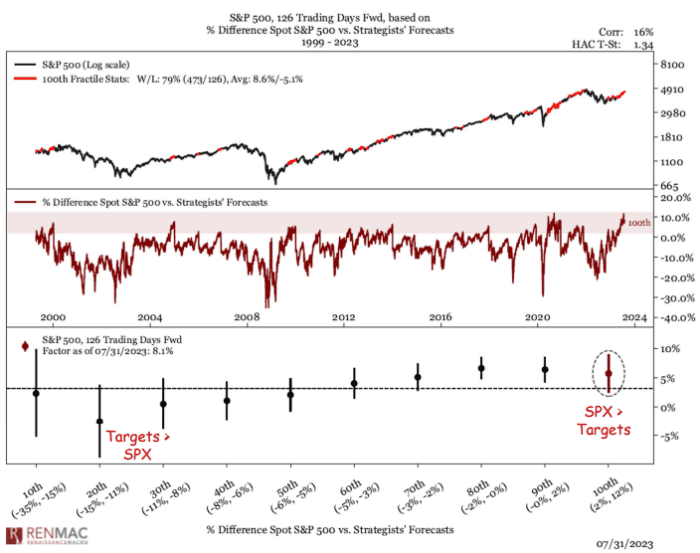Despite the U.S. stock-market rally this year bolstered by the euphoria around artificial intelligence and hopes that the U.S. economy can avoid a recession as inflation falls, stock prices have been anything but simple to predict this year, a challenge exemplified recently by some of the Wall Street’s most prominent analysts.
Oppenheimer Asset Management analysts on Tuesday projected the S&P 500 index
SPX
would rise above its record high by the end of 2023, lifting their year-end price target for the large-cap index to 4,900 from the 4,400 projection they set in December, said a team of strategists led by John Stoltzfus, chief investment strategist.
The new price target represents a roughly 7.1% increase from Tuesday’s closing price for the benchmark index, which has gained 19.2% so far this year, according to FactSet data.
“Our price target assumes that the resilience exhibited by the U.S. economy will continue along with a high level of sensitivity by the Federal Reserve in raising its benchmark rates further to slow the inflation rate toward its 2% target,” wrote Stoltzfus and his team in a Tuesday note.
Stoltzfus pointed to the expectations that U.S. inflation will continue to trend lower, the Fed’s interest rate hiking cycle appearing to be closer to a pause or an end, and “capitulation by stock-market bears is on a near wholesale basis of late,” which suggests that money held on the sidelines may flow into stocks in the months ahead and drive gains for markets.
Oppenheimer’s more bullish view came a day after Piper Sandler’s Craig Johnson boosted their year-end price target for the S&P 500 to 4,825 from 4,625, citing an improving stock-market breadth, meaning more stocks are advancing than declining which is usually indicative of a stronger and more sustainable upward trend.
Meanwhile, Citigroup analysts have raised their S&P 500 index target for the end of this year by 600 points to 4,600, a revision they said reflects the increased chances of a “soft landing” for the U.S. economy.
See: The bear market has been nearly erased. Here’s what comes next.
Last week, Morgan Stanley’s Mike Wilson, who successfully anticipated 2022’s inflation-induced bear market and has been among the stock market’s leading pessimists throughout this year, admitted that “we were wrong” about the degree to which waning inflation and the artificial-intelligence boom would boost markets in 2023.
Even though the market’s leading doomsayers sounded less bearish than usual, Wilson still sees the S&P 500 dropping to 3,900 by the end of this year, implying a 14.8% drop from where it settled Tuesday, at around 4,576. Meanwhile, his price target for June 2024 now stands at 4,200, which is around 8.2% lower than current levels, wrote a team of strategists led by Wilson, chief U.S. equity strategist and chief investment officer at Morgan Stanley, in a Monday note.
Among 20 Wall Street investment banks, brokers and research firms that MarketWatch collects S&P 500 estimates from, nearly half of them have revised upwards their estimates for 2023 in the past two months, according to data compiled by MarketWatch.
However, the spread between the most bullish and bearish S&P 500 year-end price targets still remains unusually high.
The numbers range from Oppenheimer’s 4,900 at the high end to BNP Paribas’ 3,400 at the low end. The top-end forecast is 44.1% above the low-end estimate, up from a 39.7% spread in mid-June, according to MarketWatch calculations of the data. The estimates put the average target for the S&P 500 index at 4,322 for the end of 2023, a decline of 5.6% from Tuesday’s close of 4,576 (see table below).
| Wall Street Firm | 2023 S&P 500 target as of June 13 | 2023 S&P 500 target as of August 1 |
| Oppenheimer | 4400 | 4900 |
| Fundstrat Global Advisors | 4750 | 4825 |
| Piper Sandler’s Craig Johnson | 4625 | 4825 |
| Credit Suisse | 4050 | 4700 |
| Citigroup | 4000 | 4600 |
| BMO Capital Markets | 4550 | 4550 |
| Goldman Sachs | 4500 | 4500 |
| Deutsche Bank | 4500 | 4500 |
| Evercore ISI | 4450 | 4450 |
| Société Générale | 3650 | 4300 |
| Bank of America | 4300 | 4300 |
| RBC Capital Market | 4250 | 4250 |
| JPMorgan | 4200 | 4200 |
| Jefferies | 4200 | 4200 |
| Barclays | 3725 | 4150 |
| Wells Fargo | 4100 | 4100 |
| Morgan Stanley | 3900 | 3900 |
| UBS | 3900 | 3900 |
| Capital Economics | 3900 | 3900 |
| BNP Paribas | 3400 | 3400 |
| Average | 4167.5 | 4322.5 |
| Source: MarketWatch | ||
See: The ‘narrow breadth’ chorus has fallen silent. What broadening participation in stock-market rally means for investors.
Jeff deGraaf, chairman and head of technical research at Renaissance Macro Research, said while Wall Street analysts just started adjusting their targets for the S&P 500, his model is showing the benchmark index is currently trading 10% higher above the median price forecasts (see the middle chart below).
“You would think rationally that that must be bad because the strategists will get it right and therefore the market has to come down,” said deGraaf.
However, based on his model, what happened over the past 20 years was that when the S&P 500 traded 2% to 12% above the median price target of strategists, the market would have “a meaningful higher-than-average return” over the trailing six months, deGraaf told MarketWatch via phone on Tuesday (see the bottom chart below).

SOURCE: RENAISSANCE MACRO RESEARCH
“In other words, the market gets it right more than the strategists, because [if] the strategists get it right – what you’d say is every time the S&P 500 is above the targets, it would come down to meet the targets – but that’s not what happened,” deGraaf said.
